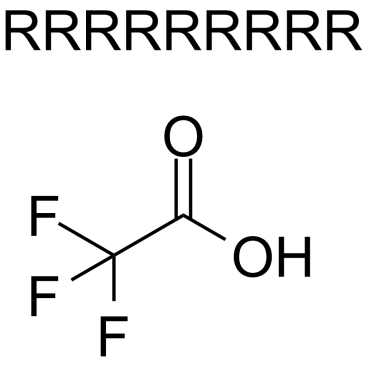(Arg)9 TFA salt
Modify Date: 2024-02-03 10:04:02

(Arg)9 TFA salt structure
|
Common Name | (Arg)9 TFA salt | ||
|---|---|---|---|---|
| CAS Number | 2283335-13-5 | Molecular Weight | 1537.71 | |
| Density | N/A | Boiling Point | N/A | |
| Molecular Formula | C56H111N36F3O12 | Melting Point | N/A | |
| MSDS | N/A | Flash Point | N/A | |
Use of (Arg)9 TFA salt(Arg)9 TFA (Nona-L-arginine TFA), a cell-penetrating peptide, exhibits neuroprotective activity with an IC50 of 0.78 μM in the glutamic acid model. |
| Name | (Arg)9 TFA |
|---|
| Description | (Arg)9 TFA (Nona-L-arginine TFA), a cell-penetrating peptide, exhibits neuroprotective activity with an IC50 of 0.78 μM in the glutamic acid model. |
|---|---|
| Related Catalog | |
| Target |
IC50: 0.78 μM (neuroprotection)[1]. |
| In Vitro | Poly-arginine (e.g. (Arg)9) and arginine-rich peptides (e.g. TAT, penetratin), which belong to a class of peptides with cell-penetrating properties are neuroprotective. (Arg)9 provides significant neuroprotection in a dose–response manner following glutamic acid exposure (IC50=0.78 μM). Following kainic acid exposure, (Arg)9 is neuroprotective, but less effective than in the glutamic acid model (IC50=0.81 μM). (Arg)9 also shows neuroprotection following in vitro ischemia (IC50=6 μM)[1]. |
| In Vivo | (Arg)9) (D-isoform) is neuroprotective in rat stroke models. (Arg)9) is highly neuroprotective, with efficacy increasing with increasing arginine content, has the capacity to reduce glutamic acid-induced neuronal calcium influx and requires heparan sulfate preotoglycan-mediated endocytosis to induce a neuroprotective effect[2]. (Arg)9) (D-isoform) administered intravenously at a dose of 1000 nmol/kg 30 min after permanent middle cerebral artery occlusion (MCAO) reduces infarct volume[3]. |
| References |
| Molecular Formula | C56H111N36F3O12 |
|---|---|
| Molecular Weight | 1537.71 |
| Storage condition | 2-8°C |